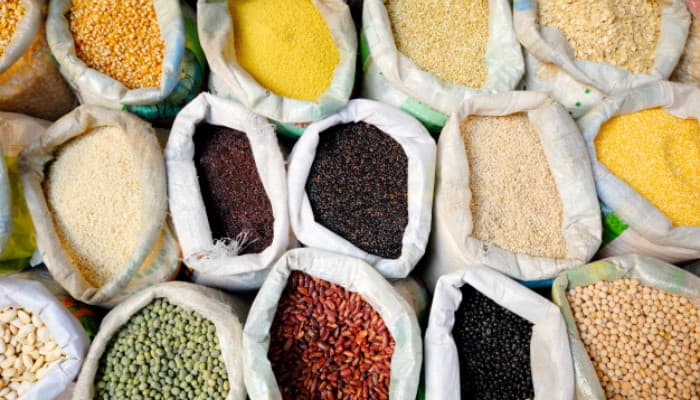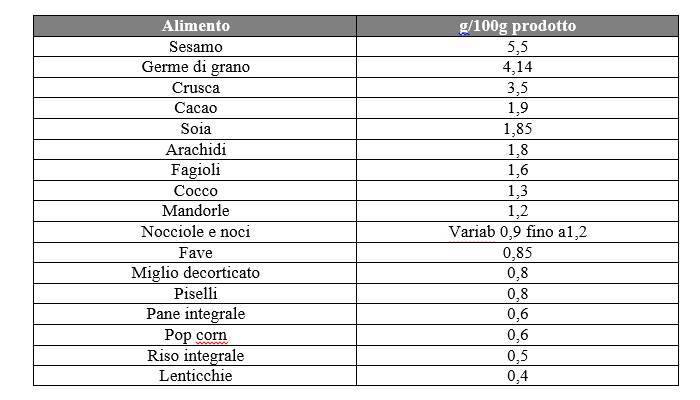 Cornice foto creata da rawpixel.com - it.freepik.com
Cornice foto creata da rawpixel.com - it.freepik.comThe phytic acid (also known as inositol esafosfato or IP6) is a unique substance that serves as a form of primary phosphorus storage in plants, important for germination and for the development of sprouts .
It also allows you to avoid bacterial attacks on the seeds when they are dormant waiting to germinate until spring is coming.
It has always been considered a anti-nutritional factor (a anti-nutrient), that is a substance that can limit the absorption or use of nutrients, in particular hinders the absorption of certain minerals ( Calcium, iron, magnesium and zinc) binding to them forming the phytase salted.
So saying the first thing that can go through the mind is " OK, I try to limit as much as possible phytic acid in the diet! " But, as always, things are more complex than that. When we talk about power we are accustomed to imagine the human body as a big tube/container that takes what it needs and throws what is not needed forgetting all phenomena, biochemical reactions, interactions that occur within it.
Phytic Acid in Food
Foods richer than this acid in general are legumes and cereals. We find it in the soy and its derivatives, in the sunflower seeds, almonds and hazelnuts and all kinds of nuts. In legumes the largest percentage is found inside while, in oilseeds, nuts and cereals, it is found mainly in the outside (Peel, bran).

All foods excluded (some minimized) by supporters of paleo diet.
These are only mean values, the content can vary widely in foods of plant origin especially with regard to walnuts and almonds.
How bad is Phytic Acid?
There are many studies that highlight the ability of the phytic acid to inhibit or limit the absorption of some minerals (iron and zinc in primis and in less quantity magnesium and calcium). But how? Under physiological conditions, phytic acid has a strong negative charge and that is why it interacts and binds positive-charged ions [iron (Fe2 +), zinc (Zn2 +), magnesium (Mg2 +), calcium (Ca2 +)) forming complexes that in the neutral pH environment of the intestine are Insoluble and tend to precipitate. Surely a diet rich in phytase can interfere with the absorption of these minerals (in extreme cases can also lead to deficiencies) but you always have to see the context, it is not the only factor: PH of the stomach and the intestinal lumen, Nature and quality of the food consumed, presence of organic acids (ascorbic acid for example) and many other factors may affect.
Properties of Phytic Acid
There is also the downside, its ability to interact with metal ions is not negative at 100%. Think of all the toxic metals (lead, cadmium etc...) present in the atmosphere and that in a small part we can find in some foods (we live in a polluted environment and not everyone daily uses food of quality, bio and of certain provenance ). Phytic acid helps to limit the absorption of these metal ions too.
The same is true of iron, a fundamental element for our organism, but it can also be dangerous. It oxidizes easily leading to the formation of free radicals like that hydroxyl (OH-) which involves severe damage to cell membranes and DNA.
The phytic acid therefore has antioxidant properties (it is used in the preparation of certain foods and for the preservation precisely for these abilities): A study carried out in vitro and on animals has put in Evidence of this ability to limit oxidative stress due to high iron percentages.
As regards the interaction with calcium, the presence of phytic acid is able to prevent the formation of kidney stones (studied with population monitoring and also thanks to in vitro studies). The phytase help to inhibit the formation of calcium oxalate (those which are often present in the analysis of the urine). Healthy subjects eliminate these oxalates with urine normally, who is predisposed to the formation of calculations will have a minor elimination and the phytase can be a valid help in this type of prevention.
Finally, there are studies that demonstrate the inversely proportional correlation between the presence of phytic acid in the diet and the susceptibility to the onset of colon cancer, vascular and neurodegenerative pathologies but for this issue there is still a work in Progress....
Techniques to reduce Phytic Acid
To reduce the content of phytic acid in the diet it is not necessary to eliminate certain categories of food, sufficient techniques and adequate preparation:
- Consume foods rich in vitamin C associated with the meal containing a good dose of phytic acid, even of simple lemon juice, parsley, spices to flavor the dishes.
- Soaking: phytic acid is soluble in water and it would be advisable to soak legumes and cereal before baking. At least 20 minutes for those who have little time, until a whole night
- Germination: a process that involves a strong reduction of the phytase and affects both legumes and cereals
- Fermentation & Leavening: They favour the disintegration of the phytase. The sour dough or sourdough are a viable alternative to brewer's yeast precisely for this reason, but leavening must be long (use of the sourdough yeast and let it rest only for 2/6 hours does not make sense, you lose all the advantages of its use).
To conclude we can say that phytic acid is a classic example of nutrient that can be both "good" and "bad", both a "friend" and an "enemy", depending on the circumstances... Everything always depends on the context, the person and the changes in time of both.
If a diet is rich and above all varies there is no reason to fear phytic acid, on the contrary, the more the diet is restrictive the greater must be attention so that it is well balanced. In addition to those who follow restrictive diets also vegan individuals or who follow a macrobiotic diet must have an eye (consuming legumes and cereal after soaking or sprouted or fermented and trying to maintain a high supply of iron, zinc, calcium and Magnesium with diet).
Bibliography
Armah SM et al. Regular Consumption of a High-Phytate Diet Reduces the Inhibitory Effect of Phytate on Nonheme-Iron Absorption in Women with Suboptimal Iron Stores. J nutr 2015 Aug;145(8):1735-9. doi: 10.3945/jn.114.209957. Epub 2015 Jun 3.
Schlemmer U. Phytate in foods and significance for humans: food sources, intake, processing, bioavailability, protective role and analysis. Mol Nutr Food Res. 2009 Sep;53 Suppl 2:S330-75
Lopez HW. Prolonged fermentation of whole wheat sourdough reduces phytate level and increases soluble magnesium. J Agric Food Chem. 2001 May;49(5):2657-62
Valencia F. Processing of quinoa (Chenopodium quinoa, Willd): effects on in vitro iron availability and phytate hydrolysis. Int J Food Sci Nutr. 1999 May;50(3):203-11
Graf E. Phytic acid. A natural antioxidant. J Biol Chem. 1987 Aug 25;262(24):11647-50
Grases F. Phytate (IP6) is a powerful agent for preventing calcifications in biological fluids: usefulness in renal lithiasis treatment. Anticancer Res. 1999 Sep-Oct;19(5A):3717-22
Hunt JR. Bioavailability of iron, zinc, and other trace minerals from vegetarian diets. Am J Clin Nutr. 2003 Sep;78(3 Suppl):633S-639S
Curated by
Dott.ssa Patalano Myriam Biologist Nutritionist
Ischia Nutrizione Patalano
